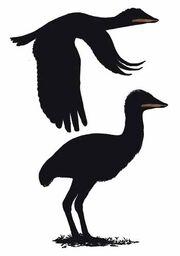No edit summary |
No edit summary |
||
| Line 1: | Line 1: | ||
| − | + | [[File:Samrukia_as_bird.jpg|thumb|Two interpretations of ''Samrukia'' as a bird]]'''''Samrukia''''' was a large archosaur, most likely a [[pterosaur]], that was originally thought to be one of the largest terrestrial birds in the [[Mesozoic]]. The only known specimen was found in [[Cretaceous]] deposits in Kazakhstan. |
|
==Description== |
==Description== |
||
| − | As |
+ | As ''Samrukia'' is known only from a single lower jaw, it is not known with certainty its anatomical details. When it was thought to be a bird, two size estimates were brought up: a wingspan of about 4 meters (if it could fly) or a height of around 2 to 3 meters (if it was terrestrial).<ref>Darren Naish, Gareth Dyke, Andrea Cau, François Escuillié and Pascal Godefroit (2012). "A gigantic bird from the Upper Cretaceous of Central Asia". Biology Letters 8 (1): 97–100. doi:10.1098/rsbl.2011.0683. '''Published online August 10, 2011'''</ref><ref>Naish, Darren (August 9, 2011). "Big birds in the Cretaceous of Central Asia: say hello to Samrukia". Tetrapod Zoology. http://blogs.scientificamerican.com/tetrapod-zoology/2011/08/09/say-hello-to-samrukia/. Retrieved August 9, 2011.</ref> |
| − | ==Classification and |
+ | ==Classification and History== |
At first, the single jaw was believed to come from an oviraptorosaur dinosaur, but it was then analyzed to be part of the bird lineage Ornithuromorpha. If ''Samrukia'' was a bird, if would be of the same size and stature as ''[[wikipedia:Gargantuavis|Gargantuavis]]'', a large, terrestrial bird from France.<ref>Buffetaut, E. & Le Loeuff, J. (1998). "A new giant ground Bird from the Upper Cretaceous of southern France." Journal of the Geological Society, 155: 1-4.</ref> The fossil was described as ''Samrukia nessovi'' by Darren Naish and Gareth Dyke in August 2011. |
At first, the single jaw was believed to come from an oviraptorosaur dinosaur, but it was then analyzed to be part of the bird lineage Ornithuromorpha. If ''Samrukia'' was a bird, if would be of the same size and stature as ''[[wikipedia:Gargantuavis|Gargantuavis]]'', a large, terrestrial bird from France.<ref>Buffetaut, E. & Le Loeuff, J. (1998). "A new giant ground Bird from the Upper Cretaceous of southern France." Journal of the Geological Society, 155: 1-4.</ref> The fossil was described as ''Samrukia nessovi'' by Darren Naish and Gareth Dyke in August 2011. |
||
| − | However, later that year its identification as a bird was challenged by Eric Buffetaut, who pointed out that the avian characteristics of ''Samrukia'' were also found on pterosaurs.<ref>Buffetaut, E. ( |
+ | However, later that year its identification as a bird was challenged by Eric Buffetaut, who pointed out that the avian characteristics of ''Samrukia'' were also found on pterosaurs.<ref>Buffetaut, E. (2011). "Samrukia nessovi, from the Late Cretaceous of Kazakhstan: A large pterosaur, not a giant bird." Annales de Paléontologie, 97(3–4): 133–138. doi:10.1016/j.annpal.2011.10.001</ref> Naish agreed with Buffetaut's reassessment, although he pointed out that ''Samrukia'' does not appear to be "just any old pterosaur."<ref>Naish, Darren (January 25, 2012). "Happy 6th Birthday, Tetrapod Zoology (part II)". Tetrapod Zoology. http://blogs.scientificamerican.com/tetrapod-zoology/2012/01/25/happy-6th-birthday-tetrapod-zoology-part-ii/. Retrieved February 22, 2012.</ref> |
==References== |
==References== |
||
| − | {{reflist}} |
+ | {{reflist}}{{Italictitle}} |
[[Category:Animals]] |
[[Category:Animals]] |
||
[[Category:Reptiles]] |
[[Category:Reptiles]] |
||
Latest revision as of 16:42, 29 January 2014

Two interpretations of Samrukia as a bird
Samrukia was a large archosaur, most likely a pterosaur, that was originally thought to be one of the largest terrestrial birds in the Mesozoic. The only known specimen was found in Cretaceous deposits in Kazakhstan.
Description[]
As Samrukia is known only from a single lower jaw, it is not known with certainty its anatomical details. When it was thought to be a bird, two size estimates were brought up: a wingspan of about 4 meters (if it could fly) or a height of around 2 to 3 meters (if it was terrestrial).[1][2]
Classification and History[]
At first, the single jaw was believed to come from an oviraptorosaur dinosaur, but it was then analyzed to be part of the bird lineage Ornithuromorpha. If Samrukia was a bird, if would be of the same size and stature as Gargantuavis, a large, terrestrial bird from France.[3] The fossil was described as Samrukia nessovi by Darren Naish and Gareth Dyke in August 2011.
However, later that year its identification as a bird was challenged by Eric Buffetaut, who pointed out that the avian characteristics of Samrukia were also found on pterosaurs.[4] Naish agreed with Buffetaut's reassessment, although he pointed out that Samrukia does not appear to be "just any old pterosaur."[5]
References[]
- ↑ Darren Naish, Gareth Dyke, Andrea Cau, François Escuillié and Pascal Godefroit (2012). "A gigantic bird from the Upper Cretaceous of Central Asia". Biology Letters 8 (1): 97–100. doi:10.1098/rsbl.2011.0683. Published online August 10, 2011
- ↑ Naish, Darren (August 9, 2011). "Big birds in the Cretaceous of Central Asia: say hello to Samrukia". Tetrapod Zoology. http://blogs.scientificamerican.com/tetrapod-zoology/2011/08/09/say-hello-to-samrukia/. Retrieved August 9, 2011.
- ↑ Buffetaut, E. & Le Loeuff, J. (1998). "A new giant ground Bird from the Upper Cretaceous of southern France." Journal of the Geological Society, 155: 1-4.
- ↑ Buffetaut, E. (2011). "Samrukia nessovi, from the Late Cretaceous of Kazakhstan: A large pterosaur, not a giant bird." Annales de Paléontologie, 97(3–4): 133–138. doi:10.1016/j.annpal.2011.10.001
- ↑ Naish, Darren (January 25, 2012). "Happy 6th Birthday, Tetrapod Zoology (part II)". Tetrapod Zoology. http://blogs.scientificamerican.com/tetrapod-zoology/2012/01/25/happy-6th-birthday-tetrapod-zoology-part-ii/. Retrieved February 22, 2012.